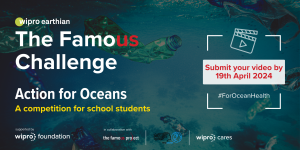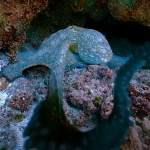The Famous Challenge- Action for Oceans
Track the journey of your waste and its impact on ocean health.
While it’s easy to view our vast oceans as limitless, assuming that a small amount of pollution is just “a drop in the ocean” and therefore insignificant, the reality is quite different. The impact of pollution on our marine ecosystems is not only significant but also devastating, with far-reaching effects on human health.
Plastic pollution in our oceans is a critical global issue. Each year, cities worldwide generate millions of tons of plastic waste that end up in our oceans, posing a substantial threat to marine ecosystems. This plastic debris, from large, discarded fishing nets to microplastics, can harm and even kill marine life such as turtles, seabirds, and whales that ingest or become entangled in it. It has been observed recently that microplastics, which are tiny fragments less than 5mm in size, have been known to enter the food chain when ingested by marine life, potentially impacting human health.
So, where does all this waste come from? The reasons for ocean plastic pollution are diverse, including littering, inadequate waste management, and industrial leakage, among others. Single-use plastics are a significant contributor, underscoring the urgent need for alternatives. This is clearly a global issue and calls for a collective effort towards sustainable solutions.
Some examples and key facts of the impacts of plastic pollution on our oceans and marine life are below:
Here’s a sobering thought- Research states that, by 2050, plastic will likely outweigh all fish in the sea. Over 400 million tons of plastic are produced every year, half of which is used to create single-use items such as shopping bags, cups, and straws. When discarded improperly, plastic waste ends up in landfills, burnt, end up in water bodies, rivers and eventually in our oceans. This leads to significant Impacts on marine life. At least 14 million tons of plastic end up in the ocean every year. Plastic debris is currently the most abundant type of litter in the ocean, making up 80% of all marine debris found from surface waters to deep-sea sediments. Marine species ingest or are entangled by plastic debris, which causes severe injuries and death.
As mentioned earlier, Microplastics are tiny plastic particles less than 5 mm in length. They originate from various sources, including cosmetics, clothing, food packaging, and industrial processes. Microplastics are now known to be harmful to both the environment and human and animal health. They enter natural ecosystems and are often consumed by marine animals. Primary microplastics are already small before entering the environment, while secondary microplastics result from the breakdown of larger plastic items. Alarmingly, standard water treatment facilities cannot remove all traces of microplastics. The long-term effects of microplastics on human and animal health are still emerging and are still being studied.
Have you heard of the Pacific Garbage Patch? It is a vast area in the North Pacific Ocean, filled with marine debris. It spans from North America’s west coast to Japan. The patch consists of two parts: the Western Garbage Patch near Japan, and the Eastern Garbage Patch between Hawaii and California. The debris, mostly microplastics, is not always visible to the naked eye. The patch is estimated to cover 1.6 million square kilometres. Alarmingly, the patch is rapidly accumulating, with the number of debris believed to have increased “10-fold each decade” since 1945.
Tackling plastic pollution requires a multi-faceted approach and requires and concerted efforts from all stakeholders-Government, businesses, civil society and individuals. A few immediate things we can do are, reduce our consumption of single-use plastics and replace them with reusable alternatives. Carrying a reusable water bottle can significantly cut down on plastic waste. Boycotting products with microbeads and cooking more often can also help. Governments on the other hand, can implement bans on single-use plastics. Improving waste management systems and promoting a circular economy are crucial. Lastly, raising awareness about the harmful effects of plastic pollution can drive behavioural changes. Each small step contributes to a larger impact in combating this global issue.



